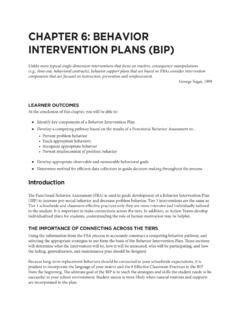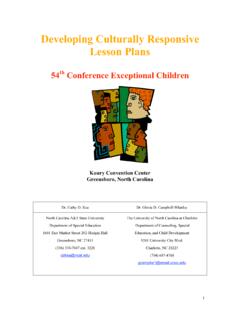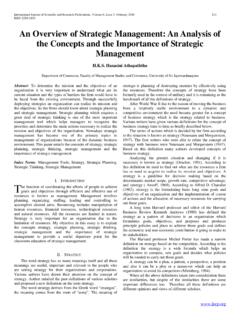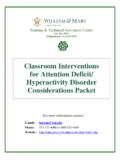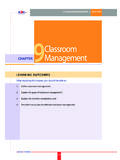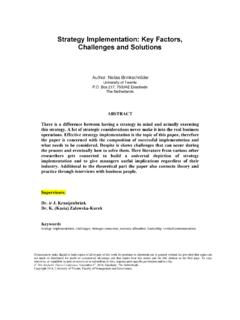Transcription of CHAPTER 8: EFFECTIVE CLASSROOM PRACTICES
1 3412018-2019 MO SW-PBS Tier 1 Team WorkbookCHAPTER 8: EFFECTIVE CLASSROOM PRACTICESLEARNER OUTCOMESAt the conclusion of this CHAPTER , you will be able to: Explain to others the power of positive and proactive strategies in establishing an EFFECTIVE CLASSROOM learning environment. Clarify expectations and procedures for your CLASSROOM , as presented in CHAPTER 3. Teach and encourage appropriate CLASSROOM behavior, and discourage inappropriate CLASSROOM behavior, as presented in Chapters 4-6. Demonstrate active supervision of the CLASSROOM . Incorporate multiple opportunities to respond into your CLASSROOM teaching. Selectively use activity sequencing and choice as needed to maintain student engagement.
2 Consider and adjust task difficulty to increase student success and diminish problem behavior. When teachers know and use positive and preventative management strategies, many of the commonly reported minor CLASSROOM behaviors can be avoided. Brenda Scheuermann & Judy Hall, 2008 EFFECTIVE CLASSROOM management is a key component of EFFECTIVE instruction, regardless of grade level, subject, pedagogy, or curriculum. Randy Sprick, Jim Knight, Wendy Reinke & Tricia McKale, 2006 The same behaviors that reduce CLASSROOM disruptions are associated with increased student learning. Jere Brophy & Thomas Good, 1986342SW-PBS & Increasing Academic Learning TimeEffective CLASSROOM managers are known not only by what they do when misbehavior occurs, but by what they do to set their classrooms up for academic success and to prevent problems from occurring.
3 (Brophy, 1998; Evertson & Emmer, 1982; Kounin, 1970). Studies continue to tell us that in many classrooms, up to half of the school day is lost to discipline and other non-instructional activities (Reinke, Herman & Stormont, 2013; Walberg, 1988; Karweit, 1988). Academic learning time, or the amount of time that students are actively and productively engaged in learning, is a strong determinant of achievement (Fisher & Berliner, 1985; Denham & Lieberman, 1980; Brophy & Good, 1986; Lewis, Newcomer, Trussell & Richter, 2006). Therefore, it is essential that our SW-PBS efforts extend the positive, proactive, and instructional approaches developed and used schoolwide and in non- CLASSROOM settings into CLASSROOM LEARNING TIMEINSTRUCTIONAL TIME the amount of the allocated time that actually results in teaching; diminished by unclear procedures, disruptive student behavior, disciplinary responses, lengthy transitions, TIME the amount of instructional time where students are actively engaged in learning.
4 Diminished by inactive supervision, limited opportunities for students to respond, poor task selection, SW-PBS has identified eight CLASSROOM PRACTICES that have been shown to increase the likelihood of appropriate behavior and decrease problem behavior while increasing academic learning time. See Figure The first four of these eight PRACTICES were presented in Chapters 3-6 and include: 1) clarifying expectations, 2) CLASSROOM procedures and routines, 3) strategies to encourage expected behavior, and 4) strategies to discourage inappropriate behavior. These PRACTICES impact instructional time the proportion of time allocated for instruction that actually results in teaching.
5 In many classrooms, the lack of clear procedures and routines ( , how to behave in small groups, participation during large group work, independent seatwork behavior, etc.), disruptive student behavior ( , out of seat, peer conflicts, etc.), and lengthy transitions, contribute to significantly diminished instructional time. An EFFECTIVE CLASSROOM manager will clarify the behaviors needed to be successful in each CLASSROOM setting or activity, teach and review those expected behaviors routinely, catch and positively acknowledge students being successful,, and provide immediate, objective correction when behavior does not meet expectations. These four PRACTICES will be briefly reviewed in this CHAPTER .
6 Four additional PRACTICES will be introduced in this CHAPTER : 1) active supervision, 2) opportunities to MO SW-PBS Eight EFFECTIVE CLASSROOM PRACTICES CLASSROOM Expectations CLASSROOM Procedures & Routines Encouraging Expected Behavior Discouraging Inappropriate Behavior Active Supervision Opportunities to Respond Activity Sequencing & Choice Task DifficultyFigure MO SW-PBS Tier 1 Team Workbookrespond, 3) sequencing and choice of activities, and 4) task difficulty. These PRACTICES positively impact engaged time, that proportion of instructional time where students are actively engaged in learning as evidenced by paying attention, responding frequently and accurately, completing work, and interacting appropriately with peers about assigned , these eight PRACTICES impact academic learning time and ultimately student achievement while ensuring a positive learning environment.
7 Implementing these evidence-based PRACTICES has been shown to maximize learning for all students while minimizing discipline problems. Many of the EFFECTIVE CLASSROOM PRACTICES we have discussed set the stage for, or increase the probability that, expected academic or social behavior will occur. Figure illustrates how EFFECTIVE CLASSROOM PRACTICES fit into the A-B-Cs of b ehavior. Establish clear CLASSROOM expectations. Increase predictability through clear procedures and routines. Teach and review expected behaviors and routines. Use pre-corrects to prompt students about expectations Actively supervise moving, scanning, and interacting. Provide a high number of opportunities to respond to academic material with high rates of success Use a brisk pace of instruction.
8 Intersperse brief and easy tasks among difficult ones. Use behavioral momentum to increase compliance. Provide opportunities for choice. Provide additional time as needed. Present material that is appropriately matched to student instructional level. Create and teach a continuum of strategies to discourage inappropriate behavior Increase student engagement with learning and task completion while displaying expected social behaviors. Provide high rates of specific positive feedback. Use a full continuum of positive Behavior ConsequenceFigure B C344 What do you currently do to ensure uninterrupted instructional time? Have all teachers clarified CLASSROOM expectations and procedures, taught them, and shared them with co-teachers, teacher assistants, and substitutes?
9 Do teachers use high rates of encouragement for students displaying expected CLASSROOM behaviors, and EFFECTIVE responses when social behavioral errors occur? What do you currently do to ensure engaged time ( , PRACTICES to ensure that students are on-task, responding frequently, and producing quality work matched to their ability)? Discuss some ways you can share what has been learned about evidence-based and EFFECTIVE instructional techniques with all staff and plan time for all to understand and practice MO SW-PBS Teacher Self-Assessment of the EFFECTIVE CLASSROOM PRACTICES on the next page is a tool that has many uses. It defines staff expectations for each EFFECTIVE CLASSROOM Practice.
10 It may be used by teachers to self-assess their implementation of each CLASSROOM practice. It also is a planning tool the SW-PBS Leadership Team can use to guide teachers as each EFFECTIVE CLASSROOM PRACTICES is being introduced. It may also be used as part of an overall check of implementation fidelity when walk-through observations are done, which is discussed in more detail at the end of this the MO SW-PBS Teacher Self-Assessment of the EFFECTIVE CLASSROOM PRACTICES on the next page. Discuss how your team might use this tool with your staff. 3452018-2019 MO SW-PBS Tier 1 Team WorkbookMO SW-PBS Teacher Self-Assessment of the EFFECTIVE CLASSROOM PracticesTIER ONE EFFECTIVE CLASSROOM PRACTICES : All staff consistently implement EFFECTIVE CLASSROOM PRACTICES to provide an engaging, predictable and safe learning environment for all CLASSROOM PracticesStaff Expectations to Support Student Behavior1.
